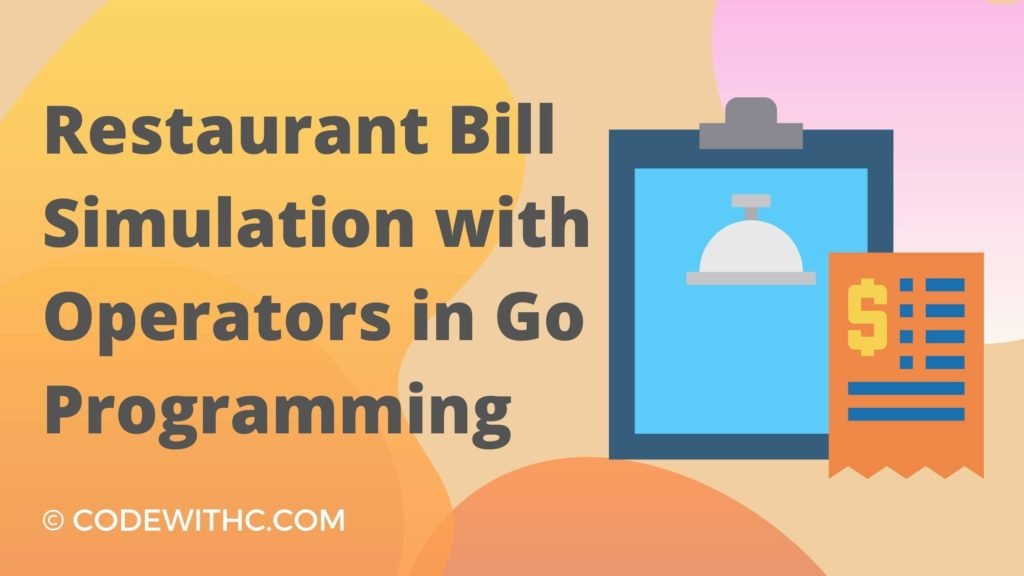Go programming language to simulate restaurant bills. Go is a great language for creating small, simple, and fun apps. However, I am not sure if Go is a good language for large and complex applications. Today, I’m going to show you how we can create a simulation of restaurant bills using Go. I will simulate different scenarios and let you decide which is the best one.
Go programming language to Simulate Restaurant bills
Bill is a restaurant manager who wants to run a successful business. He is responsible to serve food to his customers. To do that, he needs to hire some employees. The employees work together to serve the customers, so it’s important to hire the right people. For example, you may need an employee to clean the dishes. You also need to have the right kind of kitchen equipment to prepare food.
For this tutorial, I will only cover the first case where two employees need to be hired. We will use the Go programming language for this tutorial. Go is a programming language that uses the C family syntax. It was created by Google. It’s also called Golang.

To start, we need to import the packages that we will need. These include math/rand and time. Then, we can write our main function. This function will generate the scenario that we want. After that, we will make two functions to simulate the salary and hiring processes. Finally, we will write the main function to test our simulation.
package main
import (
"fmt"
"math/rand"
"time"
)
func main() {
// Create a scenario
scenario := createScenario(2, 1)
// Show the scenario
fmt.Println("\nThe scenario is: ", scenario)
// Create a new employee
createEmployee()
// Show the employees
fmt.Println("\nThe employees are: ", employees)
}
// Simulate the salary
func createEmployee() {
employees = []*Employee{
createEmployee1(),
createEmployee2()
}
}
// Simulate the hiring process
func createEmployee1() *Employee {
return &Employee{
salary: 500,
name: "Ravi",
age: 25,
occupation: "programmer",
experience: 5
}
func createEmployee2() *Employee {
return &Employee{
salary: 700,
name: "Ravi",
age: 25,
occupation: "programmer",
experience: 5
}
}
// Create a scenario
type Employee struct {
salary int
name string
age int
occupation string
experience int
}
func createScenario(numOfEmployees, numOfWaiters int) *Employee {
var employees []*Employee
for i := 0; i < numOfEmployees; i++ {
employees = append(employees, createEmployee())
}
var waiters []*Employee
for i := 0; i < numOfWaiters; i++ {
waiters = append(waiters, createEmployee())
return &Employee{
salary: employees[i].salary * waiters[i].salary,
name: employees[i].name,
age: employees[i].age,
occupation: employees[i].occupation,
experience: employees[i].experience + waiters[i].experience
}
}
// Create the employees
func createEmployee() *Employee {
var employee *Employee
return &employee
}
// Print the employees
func printEmployees() {
fmt.Println("Employees are: ", employees)
}
// Test the simulation
func testSimulation() {
testSimulation1()
testSimulation2()
testSimulation3()
}
func testSimulation1() {
// Randomly choose a waiter to be hired
random := rand.Int()
var waiter *Employee
if random < (numOfWaiters - 1) {
waiter = waiters[random]
} else {
waiter = waiters[0]
}
// Set the salary for the waiter
waiter.salary = 1500
// Set the waiter's name
waiter.name = "John"
// Set the waiter's age
waiter.age = 27
// Set the waiter's occupation
waiter.occupation = "waiter"
// Hire the waiter
waiters = append(waiters, waiter)
printEmployees()
}
func testSimulation2() {
// Randomly choose a waiter to be hired
random := rand.Int()
var waiter *Employee
if random < (numOfWaiters - 1) {
waiter = waiters[random]
}
Bill simulation is a simple problem: given several input parameters, calculate the total amount of money needed to pay for a certain amount of food and drinks in a restaurant.
The basic idea is to divide the amount of money into different categories. In each category, the total amount of money is simply added together. A category might be the “cost of the meal” or the “tip”. If the meal includes alcohol, then the cost of the meal will also include the price of the alcohol.
For the sake of simplicity, let us assume that we are in the United States and we are paying in dollars. We will not worry about currency conversion and other complexities that may arise. There are many different ways to implement a bill simulation. Some implementations will use a fixed set of categories, while others will have a flexible structure.
The algorithm used in this post is based on the following categories:
Cost of the meal: This category represents the total amount of money spent on the meal, including the cost of the food, drinks, taxes, and tip.
Tip: This category represents the total amount of money that a customer chooses to tip the waiter. The tip is subtracted from the cost of the meal.
Service charge: This category represents the amount of money that the customer is required to pay for the service provided by the restaurant. This amount might be part of the cost of the meal, or it might be a separate fee.
Tax: This category represents the total amount of money that a customer must pay for the sales tax.
Other: This category represents the total amount of money that a customer must pay for any additional charges that may appear on the bill. For example, if the customer buys a drink after the meal, then the drink will be charged as an extra charge.
We will use a simple implementation that does not have any additional categories. The implementation will only use the above categories.
The problem
We will create a simple simulator to simulate a bill. The simulator will have the following input parameters:
- Number of guests: The number of people that will be dining in the restaurant.
- Number of meals: The number of meals that will be served.
- Cost of the meal: The dollar amount that the restaurant charges for a meal.
- Number of drinks: The number of drinks that will be ordered during the meal.
- Tip: The dollar amount that a customer tips the waiter.
- Number of additional charges: The number of additional charges that will be added to the bill, such as an extra charge for a drink, tip, etc.
The simulator will output a list of numbers representing the total cost of the meal. Each item in the list represents the cost of one meal.
Implementation To implement the bill simulator, we need to write the code that implements the algorithm described above.
Here is the simple way to write the program in the Go language.
- Create a new folder as well as include a main.go documents to it:
- In main. go, include the major bundle name at the top of the documents:
package main - Import the bundles you’ll need:
import “fmt” - Create the main() function:
func main() { - The bill will certainly be divided between two people. Usage/ to divide the overall into 2 components. Create a variable to hold the total. For this item on the bill, the customer purchased
2 items cost 25 USD. We use * to do the multiplication. Then, we print a
subtotal:
// Main course
var total float64 = 2 * 25
fmt.Println(“Sub :”, total) - Here, they purchased 4 items that cost 2.25 USD. We use multiplication to get the
total of these items and then use + to add it to the previous total value and then
assign that back to the total:
// Drinks
total = total + (4 * 2.25)
fmt.Println(“Sub :”, total) - This customer is getting a discount of 5 USD. Here, we use the – to subtract 5 USD
from the total:
// Discount
total = total – 5
fmt.Println(“Sub :”, total) - Then, we use multiplication to calculate a 8% tip:
// 8% Tip
tip := total * 0.1
fmt.Println(“Tip :”, tip) - Finally, we add the tip to the total:
total = total + tip
fmt.Println(“Total:”, total) - The bill will be split between two people. Use / to divide the total into two parts:
// Split bill
split := total / 2
fmt.Println(“Split:”, split) - Here, we’ll calculate whether the customer gets a reward. First, we’ll set the
visit count and then add 1 USD to this visit:
// Reward every 5th visit
visitCount := 24
visitCount = visitCount + 1 - Then, we’ll use % to give us any remainder after dividing the visitCount by 5 USD:
remainder := visitCount % 5 - The customer gets a reward on every fifth visit. If the remainder is 0, then this is
one of those visits. Use the == operator to check whether the remainder is 0:
if remainder == 0 { - If it is, print a message that they get a reward:
fmt.Println(“With this visit, you’ve earned a reward.”)
}
} - Save the file. Then, in the new folder, run the following:
go run
You could use the Go programming language to simulate restaurant bills with operators and variables. The result will be shown in the console with the operators and variables used. This is a fun way to learn to program.







